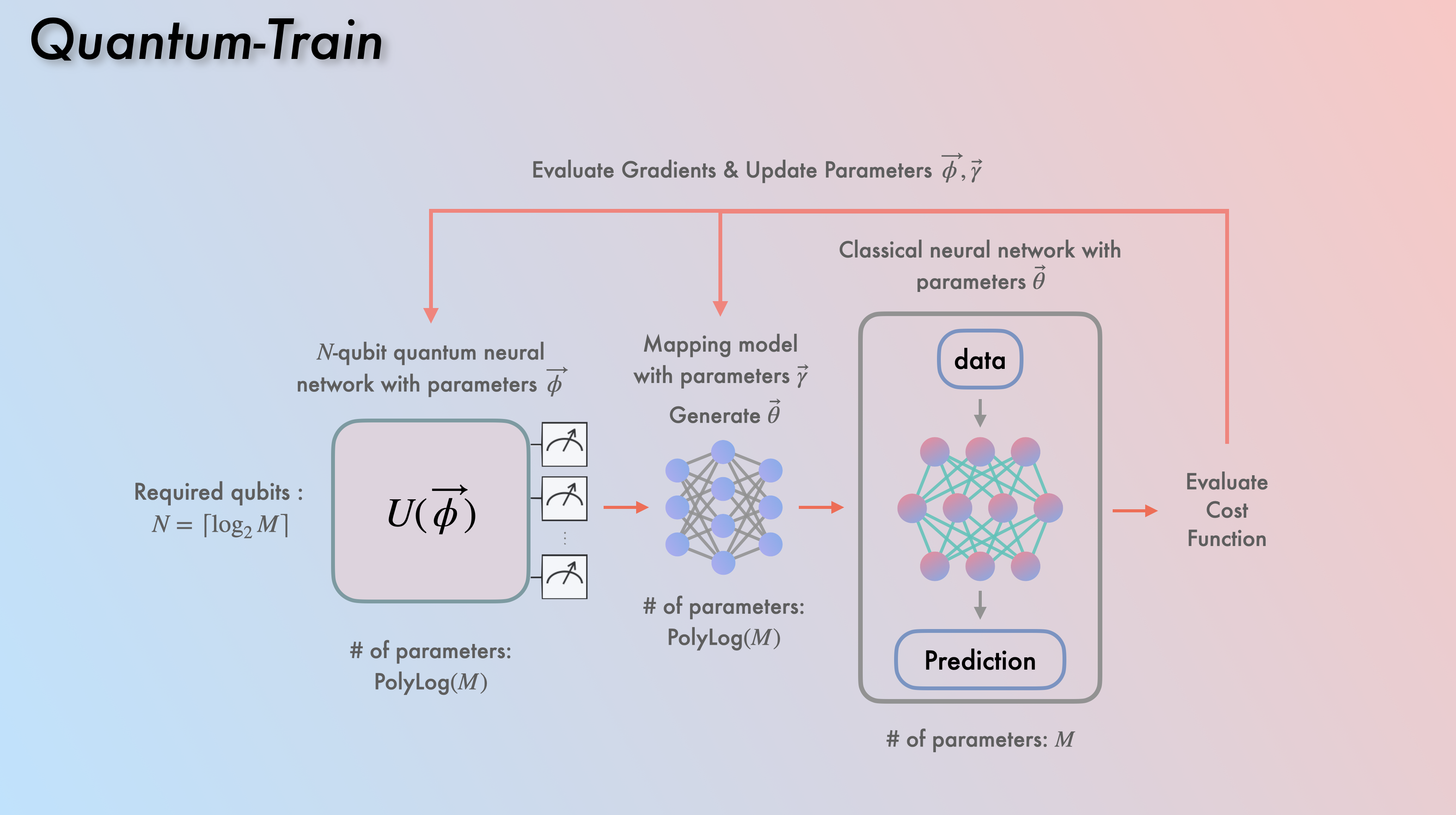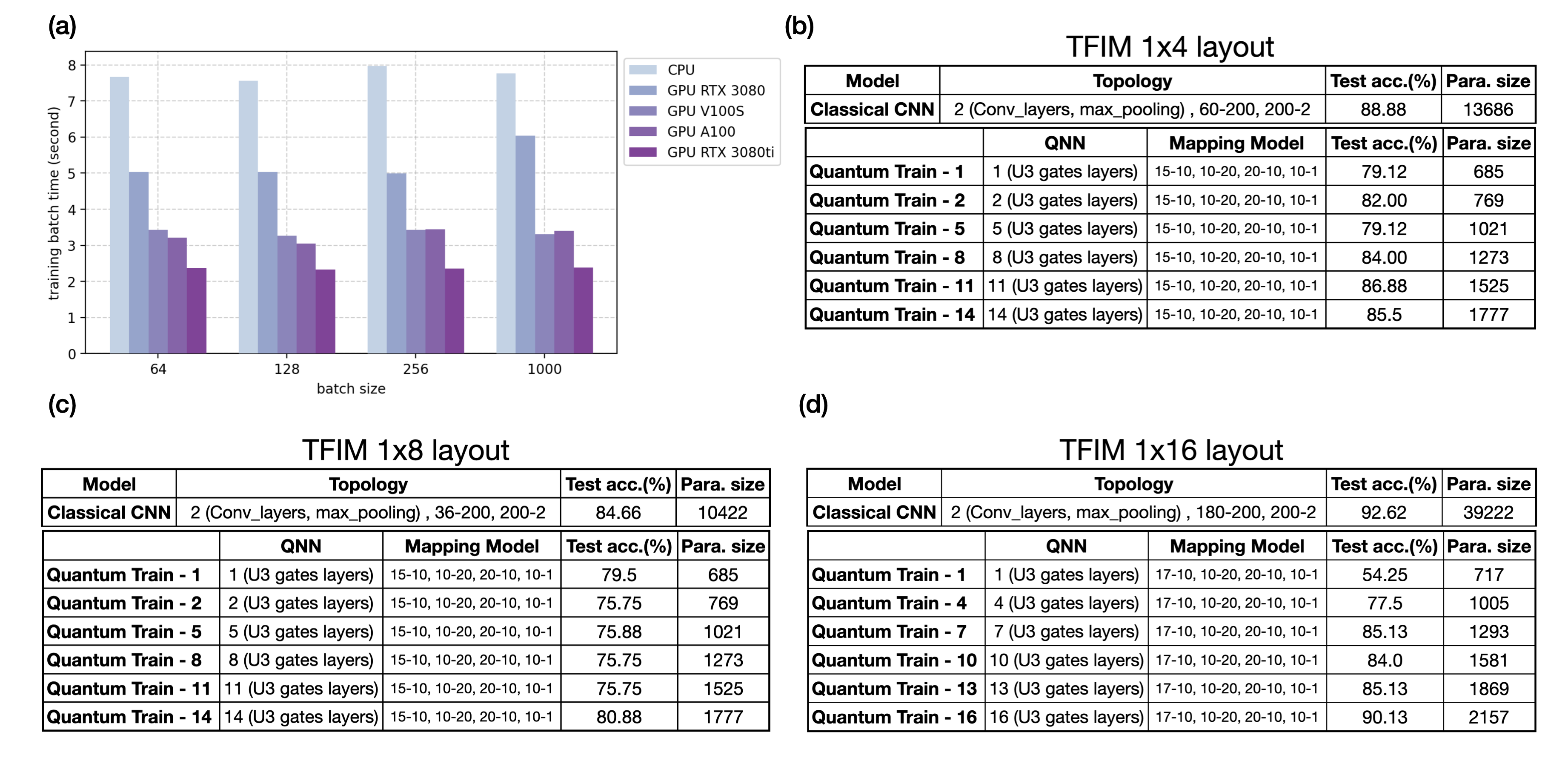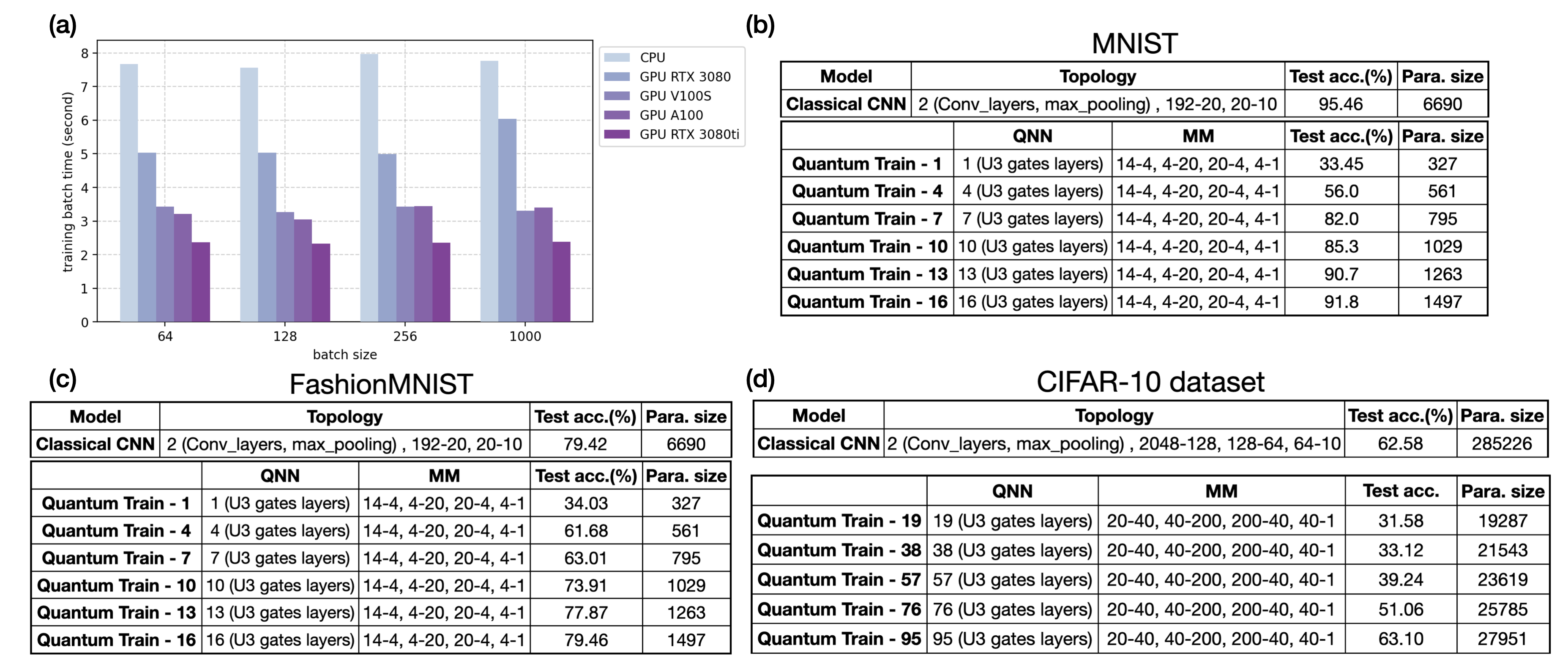Quantum-Train: Rethinking Hybrid Quantum-Classical Machine Learning in the Model Compression Perspective
Member : Chen-Yu Liu, Ya-Chi Lu, Chu-Hsuan Lin, Frank Chen
In this Hackathon project, we propose a new perspective on hybrid quantum-classical machine learning (QCML) that involves training classical neural networks (NNs) by mapping
In practice, more specifically, we need an additional mapping model (which also has
Next, we apply the QT flow described above to the phase identification problem in quantum many-body physics (A Matter of Taste challenge). Using the quantum dataset provided by PennyLane, we train a classifier that, given the classical shadow measurement result and the corresponding basis information, outputs the label of the phase, as shown in
For the example of the Transverse Field Ising Model (TFIM), data with
In this repository, we provide the source code for implementing Quantum-Train with an application to the Quantum Phase Identification problem. The workflow includes constructing training and testing data from the PennyLane quantum dataset, building a phase identification classifier, and then employing the QT technique to train the same classical model using QNN and a mapping model with a polylogarithmic reduction in parameters. An example of this process for the TFIM is demonstrated in the Quantum_Train_TFIM_1x16_L16_torchquantum.ipynb Jupyter notebook. The corresponding conda environment can be found in torchquantum_environment.yml. Please note that every result presented in this project can be reproduced by simply modifying certain parameters in Quantum_Train_TFIM_1x16_L16_torchquantum.ipynb. Thanks to the NVIDIA Power-Up, A general classifier that allow all 1x4, 1x8, and 1x16 layouts is presented in Quantum_Train_TFIM_General_classifier_L16_torchquantum.ipynb.
Additionally, for those interested in a PennyLane version of QT, it is available in Quantum_Train_TFIM_1x16_L16_pennylane.ipynb, where Lightning.gpu is built on cuQuantum. It's worth noting that this version may not be as stable as the TorchQuantum version. The corresponding PennyLane environment is specified in pennylane_environment.yml.
Besides the PolyLog reduction behavior of the proposed approach, one may also observe that we are tackling three of the main challenges in the QCML domain.
Firstly, since we are essentially generating classical NN weights through a QNN, the input and output of the ML model are entirely classical. As such, we don't have to worry about the data embedding issues associated with QNNs (for example, the need for data-loading QNN layers that impose constraints on input data size or require data compression).
The trained model is compatible with classical hardware. In fact, model inference relies solely on classical computers, enhancing its practicality, especially given the limited availability of quantum computers compared to classical ones. However, it's important to remember that we still benefit from quantum computing for its PolyLog reduction in the training process, which stems from the exponentially large Hilbert space.
Although our example in the QHack 2024 is the application to the quantum many-body physics, the proposed approach in Fig. nv. 1 is actually a general training flow for ANY QCML, QML, and ML use case, with PolyLog parameter reduction behavior. In the future, we would also like to tackle larger ML model that the parameter reduction will make the applicability totally different.
We conducted our numerical simulations of QCML primarily using TorchQuantum with NVIDIA GPUs. In fact, we experimented with Qiskit-gpu built with cuQuantum, PennyLane with Lightning.gpu (also built on cuQuantum), and cuTensorNet, and found that TorchQuantum is the most suitable for our project. It's worth noting that we also provide a PennyLane version of the code, although some details may differ. The NVIDIA GPUs we used are the NVIDIA RTX3080 and RTX3080ti with CUDA 11.6.
The use of NVIDIA GPUs led to a training speedup of up to 3.28X for the QT model proposed in this hackathon project, compared to training with a CPU, as illustrated in (a). This speedup is significant, especially given the extensive volume of training data and the prolonged duration of the training process in certain instances.
For numerical and scientific analysis, we provide some preliminary results on the TFIM. We have collected 4,000 data points for each classification task, with 20% designated as testing data and the remaining 80% used for training. Each data point consists of a matrix of size , where represents the number of spins in this case. The is derived from samples of the classical shadow measurement, while is obtained from the combined information of both the measurement result and the basis. The labels correspond to the phase of the system.
Results for the TFIM with different system layouts are presented in (b), (c), and (d), where the topology of the QT (QNN + Mapping Model), the test accuracy, and the number of parameters (parameter size) are shown, as well as the target classical model. As one may observe, the parameter size is reduced to about 12.9% for a 1x4 layout with QT-14, 17% for a 1x8 layout with QT-14, and 5.4% for a 1x16 layout with QT-16, while the test accuracies remain at a similar level.
For those interested, we also present additional results of the QT approach applied to well-known datasets such as MNIST, FashionMNIST, and CIFAR-10. The codes to generate these result are provided in the appendix_example folder. Note that there is a pennylane version of the code for CIFAR-10 dataset, and only torchquantum version for others.
-
It will be great to reconstruct the quantum state with as few as possible measurement shots in practical .
-
Efficient parameter update is crucial
-
- Parameter reduction
- Practical in real world
- No need quantum computers for inference
This project is based on and has been advanced beyond the work described in the paper:
- Training Classical Neural Networks by Quantum Machine Learning
Chen-Yu Liu, En-Jui Kuo, Chu-Hsuan Abraham Lin, Sean Chen, Jason Gemsun Young, Yeong-Jar Chang, Min-Hsiu Hsieh
arXiv preprint, arXiv: 2402.16465 (2024)
@misc{liu2024training,
title={Training Classical Neural Networks by Quantum Machine Learning},
author={Chen-Yu Liu and En-Jui Kuo and Chu-Hsuan Abraham Lin and Sean Chen and Jason Gemsun Young and Yeong-Jar Chang and Min-Hsiu Hsieh},
year={2024},
eprint={2402.16465},
archivePrefix={arXiv},
primaryClass={quant-ph}
}







